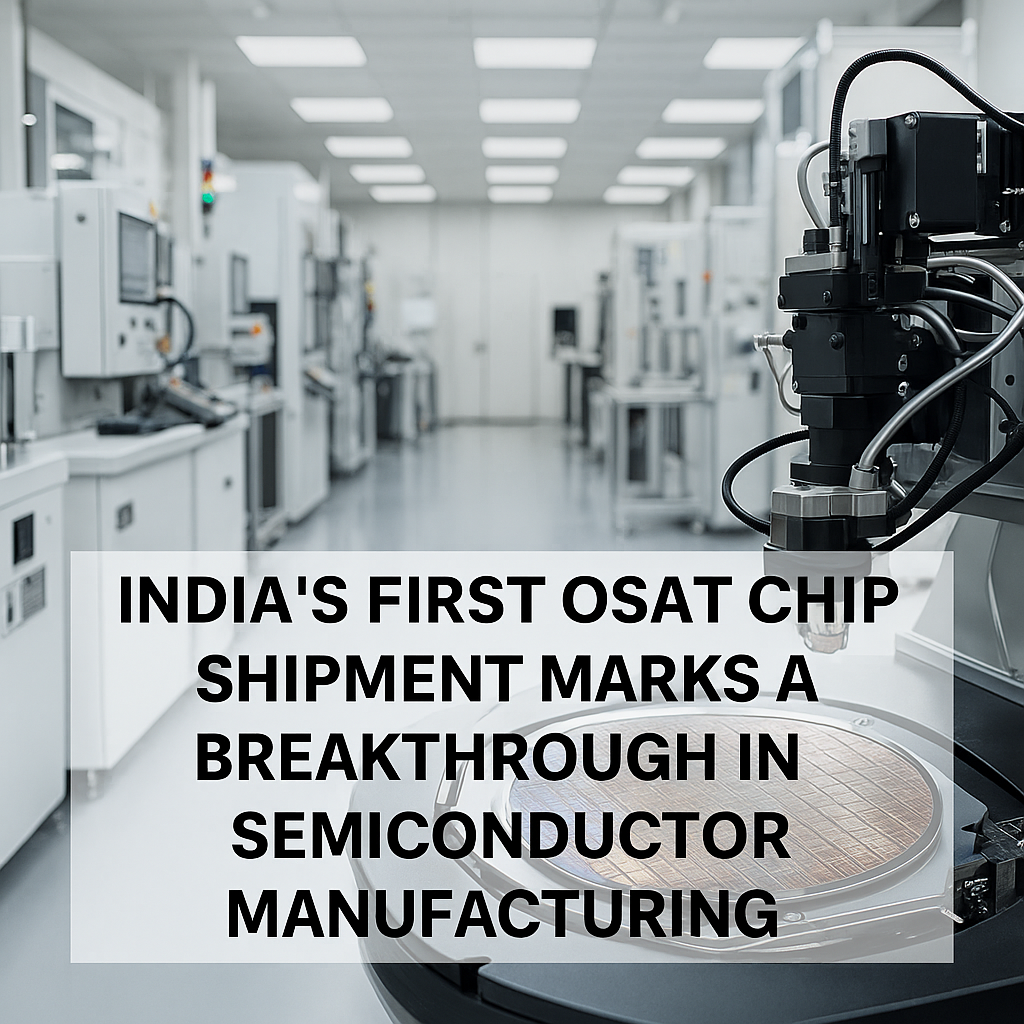India has just crossed a significant milestone in its race to become a self-reliant, high-tech manufacturing powerhouse. The country’s first commercially packaged multi-chip module (MCM) has successfully rolled out from a facility in Sanand, Gujarat. This moment is more than a manufacturing achievement; it is a statement that India is ready to take its place in the global semiconductor value chain.
On early Wednesday morning, the Sanand OSAT shipped a consignment of 900 intelligent power modules (IPMs) to California-based Alpha & Omega Semiconductor (AOS), officially marking India’s entry into export-grade semiconductor packaging and testing at a commercial scale. This development reflects the growing success of the India Semiconductor Mission (ISM 1.0) and its broader ambition to create a resilient and globally competitive semiconductor ecosystem.
India Semiconductor Mission OSAT: The Engine Behind the Breakthrough
The India Semiconductor Mission OSAT facility in Sanand was developed with a central investment of ₹1,653.5 crore and is one of the flagship projects under India Semiconductor Mission 1.0, a government-backed initiative to reduce India’s dependency on imported semiconductors and to build end-to-end chip manufacturing capabilities within the country.
The facility began pilot manufacturing in April 2024, and less than a year later, it has already delivered export-grade high-tech modules to a major international player. This is a strong indicator that the government’s focused policy initiatives, combined with industry collaboration, are beginning to bear fruit.
What Are Intelligent Power Modules (IPMs) and Why Do They Matter?

An Intelligent Power Module (IPM) is a highly integrated semiconductor device that consolidates power switching elements, such as insulated gate bipolar transistors (IGBTs), alongside control and protection circuitry into a single compact chip. These modules are used in a wide array of modern technologies, especially in:
- Electric Vehicles (EVs)
- Renewable energy systems
- Motor control applications
- Industrial automation
This particular IPM is not an ordinary chip, it contains 17 dies inside, including:
- 6 IGBTs
- 2 controller integrated circuits (ICs)
- 6 fast recovery diodes (FRDs)
- 3 standard diodes
This level of integration places the module among the most advanced in its class, and according to Raghu Panicker, CEO of Kaynes Semicon, it is a rare and highly sophisticated achievement. “Companies generally think of doing single-die packaging. We delivered a multi-chip module,” Panicker said, speaking to The Economic Times.
Why This Matters to India’s Chipmaking Aspirations
Until recently, India’s role in the global semicon supply chain was largely limited to design and software services, with minimal domestic capabilities in high-end chip packaging, assembly, or testing. This delivery represents a paradigm shift, India is no longer just participating; it is producing.
This development is a strong endorsement of India’s “Make in India” and “Digital India” initiatives. The OSAT facility in Gujarat now gives India a critical capability it lacked before, the ability to assemble and test advanced semicon modules at commercial scale for export markets.
Such capabilities are not only vital for strategic autonomy but also essential for attracting global investment, encouraging domestic R&D, and catalyzing the growth of local supply chains for raw materials, substrates, packaging, and testing tools.
The Global Context: How India Is Positioning Itself
The world’s semiconductor supply chain is undergoing major shifts. The U.S.-China tech rivalry, coupled with supply chain disruptions caused by the COVID-19 pandemic and geopolitical tensions, has pushed nations to localize and secure chip production. Countries like the United States, Taiwan, South Korea, and Japan have already established robust semiconductor ecosystems. India is now joining that elite list by building OSAT and fabrication capacities at a national level.
Companies such as Infineon, which currently lead the global IPM segment, now face rising competition from Indian manufacturers like Kaynes Semicon, which have demonstrated the capability to deliver high-complexity modules.
India’s entry into the multi-chip module market could not have come at a better time. With the demand for semiconductors growing at double digits annually, especially for electric mobility and smart energy systems, there is a clear and pressing need for diversified supply sources.
Global Partnership Begins
The shipment of 900 IPMs to Alpha & Omega Semiconductor (AOS), a reputed California-based chipmaker, is more than just a business transaction, it is an early validation of India’s technical capabilities and reliability as a manufacturing partner.
Raghu Panicker, CEO of Kaynes Semicon, noted that this shipment was a full turnkey delivery, the chip was not only assembled in India but also tested, marked, packaged, and certified at the Sanand OSAT before being shipped to the U.S. This end-to-end execution showcases India’s potential to serve global clients with world-class chip packaging services.
The facility currently handles up to 3,000 pieces per day, and a second shipment to AOS is expected next month. This steady production rhythm signals scalability and long-term viability.
Also Read: Unveiling the World of Semiconductors: From Silicon to Software, India’s Pioneering Journey
Job Creation and Ecosystem Development
The Sanand OSAT isn’t just a factory, it’s a jobs engine and a skills accelerator. As semiconductor packaging and testing involve precision, cleanroom operations, and advanced engineering, the facility provides employment across a spectrum of roles, from engineers and technicians to logistics and quality assurance professionals.
Moreover, the project has already begun to attract ancillary industries, including local suppliers of cleanroom gear, silicon wafers, bonding wire, and chip carriers. The long-term impact is the creation of a complete semiconductor packaging ecosystem, which can later support domestic design startups and fabless companies.
What Lies Ahead for the India Semiconductor Mission?
The success of this initial OSAT shipment sets the stage for the next phase of the India Semiconductor Mission (ISM 2.0). With fabrication units (fabs), testing labs, and design innovation centers being planned in multiple Indian states, the future looks promising.
Already, states like Karnataka, Tamil Nadu, and Maharashtra are positioning themselves as future semiconductor hubs, offering infrastructure, policy support, and incentives to attract both Indian and foreign players.
Additionally, with PLI (Production Linked Incentive) schemes for semiconductors and electronic components gaining momentum, India is expected to become a top global destination for semiconductor investment by 2030.
Conclusion: A Historic First, and a Sign of Things to Come
The rollout of India’s first multi-chip module from the Sanand OSAT is a historic first, and perhaps the most visible sign that India’s semiconductor dreams are becoming reality. This breakthrough proves that India can not only participate in but also lead complex parts of the global chipmaking process.
With continued government support, a rapidly growing domestic electronics market, and a pool of skilled talent, India is well on its way to becoming a semiconductor superpower in the next decade. The shipment to AOS is just the beginning, what follows could redefine India’s standing in the global technology arena.
Reference: The Economic Times
